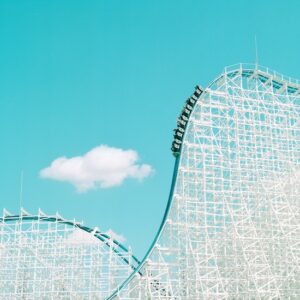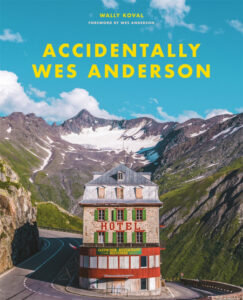Accidentally Wes Anderson
by Wally KovalThe saturated colours, surreal architecture and surprising landscapes in the films of Wes Anderson have inspired a phenomenal photographic archive which has gathered well over a million followers on Instagram. Accidentally Wes Anderson, curated by Wally Koval, gathers images from around the world that capture or interpret the filmmaker’s signature aesthetic: an enthralling mixture of perfect symmetry, unexpected juxtapositions, vibrant patterns and distinctive hues. The best of these are now collected in a stunning book packed with quirky landmarks and undiscovered gems, together with the fascinating stories behind them. It all serves as an impossible-to-complete bucket list of must-see destinations, and an irresistible invitation to look at the world around us with a heightened sense of awe and appreciation.
Cover image: Hotel Belvédère, Furka Pass, Switzerland, c. 1882 © Carlo Küttel
 Roberts Cottages, Oceanside, California, c. 1928 © Paul Fuentes
Roberts Cottages, Oceanside, California, c. 1928 © Paul Fuentes
Shortly after the town layout was completed in 1883, Oceanside, California was marketed as a seaside resort. In 1928, A.J. Clark bought a sizable strip of land, secured a permit, and built twenty-four beach cottages. The small pastel-coloured homes, framed by the carnations and geraniums planted throughout Oceanside, opened for business by midsummer.
Harry and Virginia Roberts purchased the iconic double row of homes in 1941. Within a dozen years, investors began to sell the quaint cottages individually. Ocean view homes sold for $5,950, while second-row units went for $700 less.
The buildings, now rental bungalows, still stand, representing an important moment in Oceanside’s nascent days, a time when the town enticed visitors with the tremendous promise that “If you long for a beautiful country, with a matchless climate, come to Oceanside, where life is worth living.”
Click on any image to enlarge and view in slideshow
 Ascensor da Bica, Lisbon, Portugal, c. 1892 © Jack Spicer Adams
Ascensor da Bica, Lisbon, Portugal, c. 1892 © Jack Spicer Adams
Built in 1892, the charming Ascensor da Bica is one of Lisbon’s three funicular railway cars. A funicular railway car differs from a standard tram through its reliance on its twin. Two passenger vehicles are pulled on a slope by a single cable looped around a pulley wheel at the top. The pair move in perfect synchronicity: one vehicle ascends as its descending partner counterbalances it.
This unique mode of co-dependent public conveyance, which bears similarities to a kind of outdoor elevator, was initially powered by a water system – a car at the top of the hill was loaded up with water until it was heavy enough for gravity to assist in its descent, thus pulling its counterbalanced twin up to the top of the hill. In 1896 the system became steam-powered, and in 1924 it was electrified.
Ascensor (or Elevador) de Bica climbs 800 feet up one of Lisbon’s steepest hills. A delightful, leisurely ride and a hop off at the top leads you to Miradouro de Santa Luzia, a terrace from which to marvel at the distinctive rooftops of the city.
 The White Cyclone at Nagashima Spa Land, Kuwana, Japan, c. 1994 © Paul Hiller
The White Cyclone at Nagashima Spa Land, Kuwana, Japan, c. 1994 © Paul Hiller
Nagashima Spa Land opened in 1966 with close to fifty amusement rides and a hot springs water park. Spa Land’s ten roller coasters command the longest lines – the most famous being the Steel Dragon 2000, which spans the entire length of the park and ascends a hill reaching 318 feet into the sky.
Close behind it in popularity was the White Cyclone, a wooden roller coaster that opened in 1994. The ride was unusually fast for a wooden roller coaster, incorporating elements such as helixes and extreme drops. Wooden coasters are extremely rare in Japan, a country with strong regulations on tree felling; the Cyclone was constructed with enough timber to build nearly a thousand homes. When time came for renovation, it was replaced by a steel-tracked coaster named Hakugei, or the White Whale.
After a fourteen-year run, the Cyclone made its last spin in January 2018. The White Whale surfaced a year later, offering a smoother, more durable ride and an extra 40 feet of a drop – perhaps to compensate for rider nostalgia.
Accidentally Wes Anderson is published in hardback by Trapeze, an imprint of Orion.
Read more
accidentallywesanderson.com
@accidentallywesanderson
@AccidentallyWA
@orionbooks


